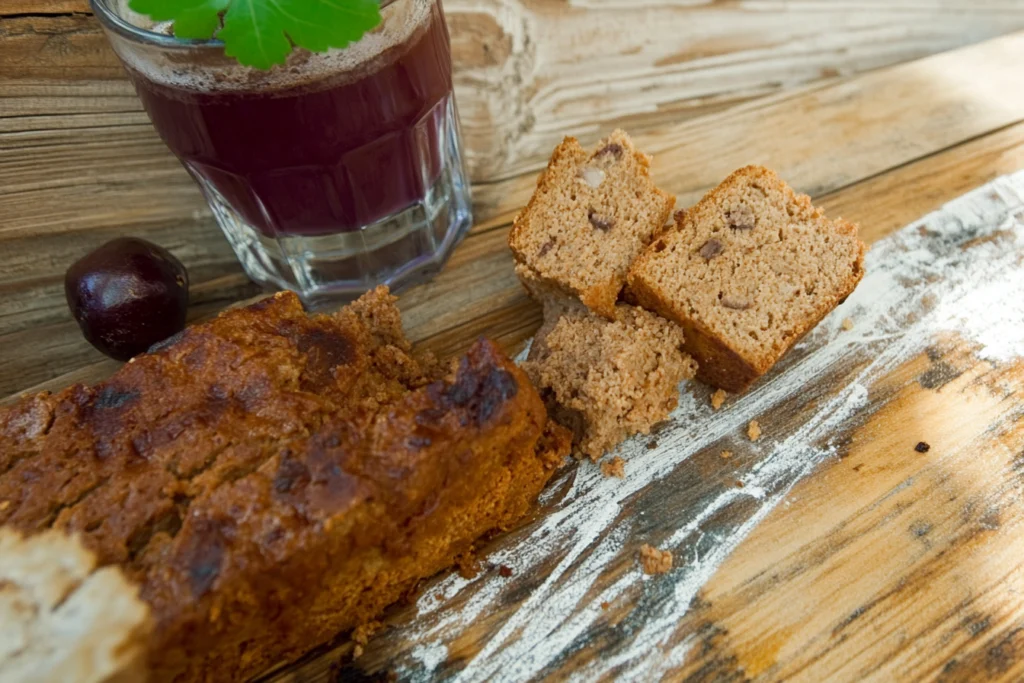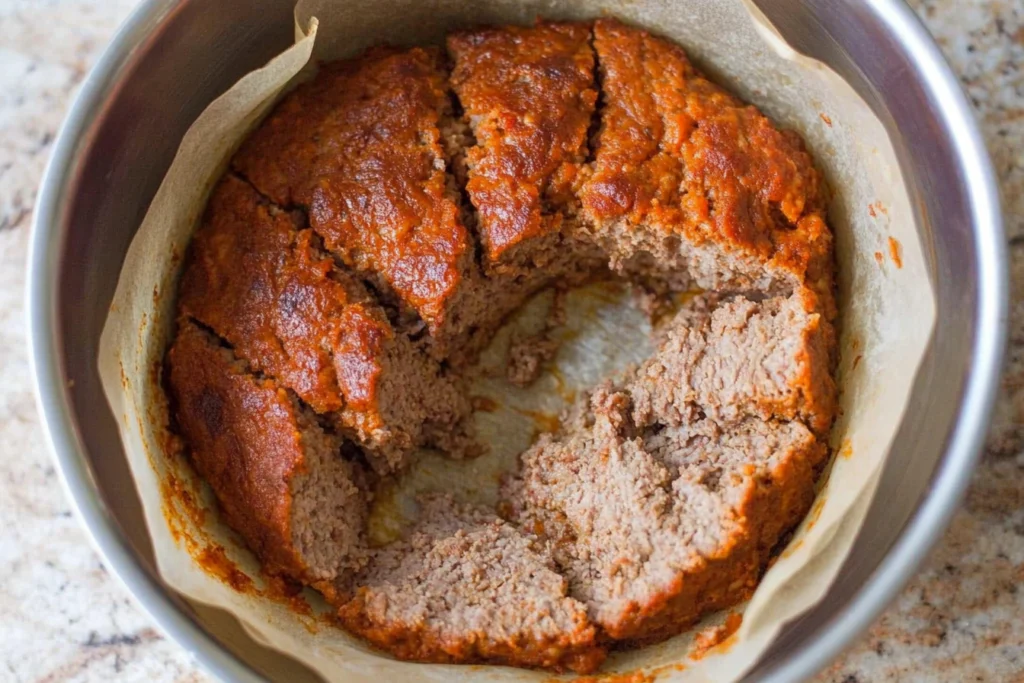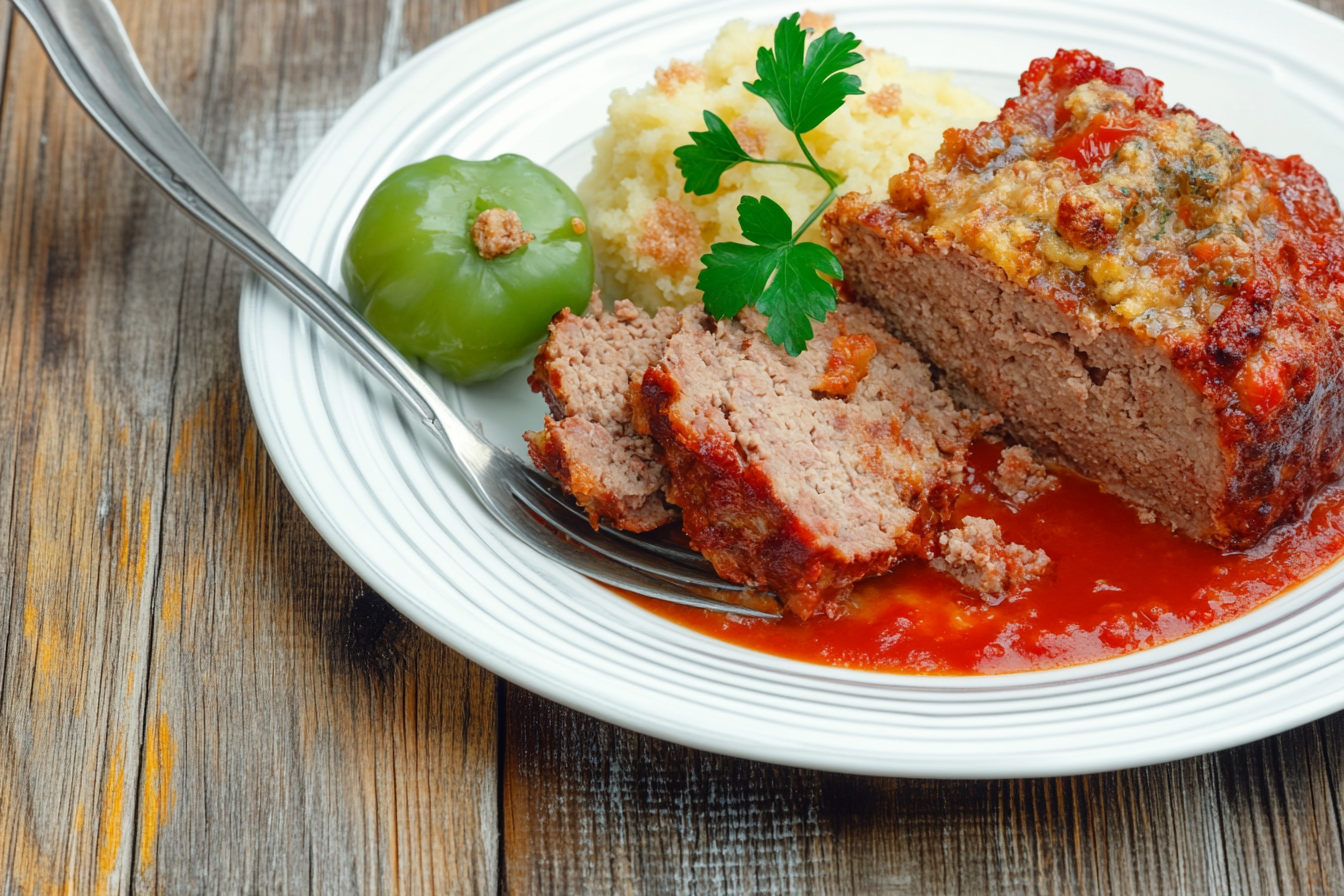Introduction to Meatloaf Mixture
The meatloaf mixture is a quintessential blend of ingredients that creates one of the most beloved comfort foods worldwide: meatloaf. Known for its versatility and hearty appeal, meatloaf is more than just a simple dish—it’s a culinary tradition.
What Is Meatloaf?
At its core, meatloaf is a baked dish made by combining ground meat with binding agents and seasonings, often shaped into a loaf. Its versatility makes it a staple in various cuisines, with each culture adding unique ingredients and techniques to adapt it to local palates.
This dish stands out for its adaptability. It can be tailored to include various proteins, seasonings, and even vegetables, making it suitable for diverse dietary needs. Whether served hot with mashed potatoes or cold in sandwiches, meatloaf remains a timeless favorite.
Historical Origins of Meatloaf
Meatloaf traces its roots back to ancient Rome, where cooks combined minced meat with wine-soaked bread and spices. Over centuries, this concept evolved across Europe and America, becoming a means to stretch meat supplies during tough economic times.
In the U.S., meatloaf gained prominence during the Great Depression, when home cooks innovatively combined affordable ingredients to feed their families. This economic ingenuity transformed meatloaf into the cherished comfort food we know today.
Overview of Meatloaf Mixture Components
A traditional meatloaf mixture typically consists of the following core components:
- Meat as the primary ingredient.
- Binding agents, such as eggs and breadcrumbs.
- Flavor enhancers, including seasonings and spices.
- Moisture additives like milk or broth.
- Optional ingredients for customization, such as vegetables or cheeses.
Let’s delve deeper into these components to understand their significance and roles.
Meat as the Base Ingredient
The foundation of any meatloaf mixture is ground meat. The choice of meat significantly impacts the flavor, texture, and nutritional profile. Common options include:
- Beef for its robust flavor.
- Pork or veal to add richness.
- Turkey or chicken as leaner, healthier alternatives.
A combination of meats is often used to strike a balance between flavor and moisture.
Binding Agents: Eggs and Breadcrumbs
Binding agents are crucial for holding the meatloaf mixture together, preventing it from crumbling. Key binders include:
- Eggs, which provide structure and moisture.
- Breadcrumbs, acting as fillers to absorb excess moisture and create a uniform texture.
Different types of breadcrumbs—such as panko or regular—offer varying textures and results.

Flavor Enhancers: Seasonings and Spices
The seasonings and spices in a meatloaf mixture transform it from bland to flavorful. Common choices include:
- Garlic and onion powder for depth.
- Paprika for a subtle smokiness.
- Herbs like parsley, thyme, or oregano for freshness.
Experimenting with seasoning combinations can personalize your meatloaf to suit your taste preferences.
Moisture Additives: Milk or Broth
Moisture additives prevent meatloaf from becoming dry and tough. Popular options are:
- Milk, which keeps the mixture tender and rich.
- Broth for adding a savory depth of flavor.
These liquids also help distribute flavors evenly throughout the mixture.
Optional Ingredients for Customization
The beauty of a meatloaf mixture lies in its flexibility. Additional ingredients can elevate the dish, such as:
- Grated vegetables like carrots or zucchini for added nutrition.
- Cheeses like Parmesan or cheddar for a creamy element.
- Special seasonings like Worcestershire sauce or mustard for complexity.
By tailoring the ingredients, you can create a meatloaf mixture that reflects your unique taste.
The Role of Meatloaf Mixture in Modern Cuisine
In modern cuisine, meatloaf has evolved from a humble, home-cooked dish to a sophisticated offering on restaurant menus. Creative twists, such as gourmet glazes or unexpected fillings, have breathed new life into this classic.
Additionally, meatloaf mixtures cater to diverse dietary trends, with gluten-free and plant-based versions becoming increasingly popular. This adaptability ensures its continued relevance in kitchens worldwide.
Key Ingredients in a Traditional Meatloaf Mixture
Choosing the Right Type of Meat
The type of meat you choose is the cornerstone of your meatloaf mixture. It determines the flavor, texture, and even the nutritional profile of your dish. While traditional recipes often use beef, modern variations incorporate a mix of meats to enhance flavor and moisture.
Beef: The Most Common Choice
Ground beef is the classic base for most meatloaf recipes. Its rich flavor and higher fat content contribute to the moist, tender texture that makes meatloaf so satisfying.
- Fat Content: Choose ground beef with about 80% lean and 20% fat for the best balance of flavor and texture.
- Flavor Pairing: Beef pairs well with bold seasonings like garlic, onion, and Worcestershire sauce, making it a versatile option.
While leaner beef (90% lean) can be used for a healthier alternative, it may require additional moisture additives, such as broth or milk, to avoid dryness.
Combining Pork or Veal for Flavor
Mixing ground pork or veal with beef creates a meatloaf that is both rich and tender. Pork adds juiciness, while veal contributes a softer texture.
- Proportions: A common ratio is 2 parts beef to 1 part pork or veal.
- Enhancements: These meats naturally blend well with herbs like thyme, parsley, or sage, enhancing the overall flavor complexity.
This combination is often seen in gourmet meatloaf recipes, delivering a depth of flavor that pure beef cannot achieve alone.
Turkey and Chicken as Leaner Options
For a lighter, healthier version of meatloaf, ground turkey or chicken can replace red meats. These lean proteins offer a mild flavor and fewer calories.
- Moisture Challenges: Because turkey and chicken are lower in fat, they require additional moisture, such as grated vegetables or a splash of broth.
- Seasoning: Enhance their mild taste with bold spices, like paprika or cumin, and fresh herbs like cilantro or basil.
Turkey and chicken meatloaves are ideal for those following low-fat or heart-healthy diets.
The Importance of Binding Ingredients
Binding ingredients ensure that the meatloaf holds together while adding moisture and texture. Eggs and breadcrumbs are the go-to choices, but there are variations to suit specific dietary needs.
The Function of Eggs in Meatloaf
Eggs are a multitasking ingredient, playing several critical roles in the meatloaf mixture:
- Structural Integrity: The proteins in eggs firm up when cooked, holding the ingredients together.
- Moisture Retention: Eggs keep the meatloaf tender and juicy.
- Flavor Enhancement: They add a subtle richness to the overall taste.
For egg-free alternatives, flaxseed meal mixed with water or unsweetened applesauce can be used as binders.
Types of Breadcrumbs: Panko vs. Regular
Breadcrumbs act as a filler, absorbing moisture and creating a uniform texture. Choosing the right type can significantly affect the outcome:
- Regular Breadcrumbs: These provide a smooth, consistent texture and are widely available.
- Panko Breadcrumbs: Light and flaky, panko creates a more delicate, airy texture, making it a favorite for modern meatloaf recipes.
- Seasoned Breadcrumbs: These come pre-flavored, reducing the need for additional seasoning.
For those avoiding gluten, alternatives like almond flour, crushed rice crackers, or oatmeal work well without sacrificing texture.
Enhancing the Flavor Profile
Seasonings and spices are what elevate a meatloaf from ordinary to extraordinary. They add layers of flavor that make each bite memorable.
Common Spices: Garlic, Onion, and Paprika
Classic spices like garlic powder, onion powder, and paprika provide a solid flavor base:
- Garlic Powder: Adds a deep, savory taste.
- Onion Powder: Infuses sweetness and depth without the sharpness of raw onions.
- Paprika: Offers a hint of smokiness or sweetness, depending on the variety.
Using fresh minced garlic or onions instead of powdered forms can add a more robust and aromatic flavor to your meatloaf.
Fresh vs. Dried Herbs in Meatloaf
Herbs are a vital component of the meatloaf mixture, bringing freshness and vibrancy to the dish.
- Fresh Herbs: Use parsley, thyme, or rosemary for bright, aromatic flavors. Chop them finely to distribute evenly throughout the mixture.
- Dried Herbs: Convenient and long-lasting, dried herbs like oregano or basil can also work but should be used in smaller quantities as their flavors are more concentrated.
The choice between fresh and dried herbs often depends on availability and personal preference. For a balanced flavor, consider using a mix of both.
Balancing Flavor and Texture
The key to a perfect meatloaf is finding harmony between flavor, texture, and moisture. By choosing the right combination of meats, binding agents, and seasonings, you can create a dish that is not only cohesive but also bursting with flavor.
Whether you stick to traditional ingredients or experiment with modern variations, understanding the role of each component ensures that your meatloaf will turn out perfectly every time.
Customizing Meatloaf Mixtures
Adding Vegetables for Texture and Flavor
Incorporating vegetables into a meatloaf mixture enhances both texture and flavor, while also adding nutritional value. Vegetables provide moisture, a slight crunch, and a subtle sweetness that balances the savory richness of the meat.
Common Choices: Carrots, Celery, and Bell Peppers
- Carrots: Grated carrots add moisture and a hint of natural sweetness, enhancing the overall flavor profile.
- Celery: Chopped celery lends a subtle crunch and aromatic freshness, creating a balance in texture.
- Bell Peppers: Whether red, green, or yellow, diced bell peppers contribute a pop of color and a mild, sweet flavor.
These vegetables not only improve the texture but also offer an opportunity to incorporate more vitamins and fiber into the dish.
Grated vs. Chunked Vegetables
The way you prepare the vegetables significantly affects the meatloaf’s texture:
- Grated Vegetables: Blend seamlessly into the mixture, adding moisture and flavor without being overly noticeable.
- Chunked Vegetables: Create a rustic texture, with distinct pieces adding visual and textural interest.
Both methods are effective, so the choice depends on whether you prefer a uniform texture or a more rustic, hearty meatloaf.
Incorporating Cheeses into Meatloaf
Cheese adds a luxurious, creamy element to meatloaf, elevating its flavor profile and texture. Depending on the type of cheese, it can provide a tangy kick, a nutty undertone, or a gooey center.
Types of Cheese: Cheddar, Parmesan, or Mozzarella
- Cheddar: A popular choice for its sharp, bold flavor. Mix it into the meatloaf or sprinkle it on top for a melted crust.
- Parmesan: Adds a nutty, savory depth that pairs well with Italian-inspired seasonings.
- Mozzarella: Known for its mild flavor and excellent melting properties, mozzarella can create a gooey, cheesy surprise when layered in the center.
For those looking to experiment, blue cheese or gouda can add a sophisticated twist to traditional recipes.
Experimenting with Glazes and Toppings
The glaze is the finishing touch that defines the exterior flavor and appearance of the meatloaf. It can range from sweet and tangy to savory and spicy, depending on your preferences.
Ketchup, Barbecue Sauce, or Honey Mustard
- Ketchup: A classic choice that caramelizes during baking, creating a sweet and tangy crust.
- Barbecue Sauce: Adds a smoky, bold flavor, perfect for those who enjoy a Southern-style twist.
- Honey Mustard: Combines sweetness and tanginess for a unique, balanced glaze.
These glazes can be brushed on before baking or added in layers during cooking to build depth and complexity.
Alternative Topping Ideas
For a modern spin, consider these innovative topping options:
- Pesto: Adds a fresh, herbaceous flavor that complements lighter meats like chicken or turkey.
- Chutney: A sweet-and-savory fruit glaze that pairs well with pork or veal.
- Crispy Onion Straws: Provides a crunchy, savory topping that contrasts beautifully with the soft interior.
The right topping can transform a simple meatloaf into a gourmet masterpiece.

Meatloaf Mixture for Special Diets
The meatloaf mixture is highly adaptable, making it suitable for various dietary restrictions and preferences. With thoughtful substitutions, you can create versions that cater to gluten-free, vegetarian, or vegan lifestyles.
Gluten-Free Alternatives for Binders
Traditional breadcrumbs can be replaced with gluten-free options without compromising texture:
- Oats: Rolled oats or quick oats provide a hearty texture and bind the mixture well.
- Crushed Rice Crackers: Mimic the effect of breadcrumbs while maintaining a light texture.
- Almond Flour: Adds a nutty flavor and works as an effective binder.
Ensure any additional seasonings or sauces used are also gluten-free.
Vegetarian or Vegan Meatloaf Mixtures
For plant-based versions, replace the meat with alternatives like:
- Lentils: Cooked lentils create a hearty, protein-packed base.
- Mushrooms: Finely chopped mushrooms mimic the texture of ground meat while adding umami flavor.
- Plant-Based Meat Alternatives: Products like Beyond Meat or Impossible Meat work seamlessly in traditional recipes.
Binders can also be substituted with flaxseed meal or chia seeds mixed with water, and the result is a meatloaf that’s just as satisfying as its meat-based counterpart.
Balancing Creativity and Tradition
Customizing your meatloaf mixture allows you to honor its traditional roots while introducing new and exciting elements. Whether you’re adding vegetables for nutrition, experimenting with cheeses, or creating unique glazes, there’s no limit to how you can personalize this classic dish.

